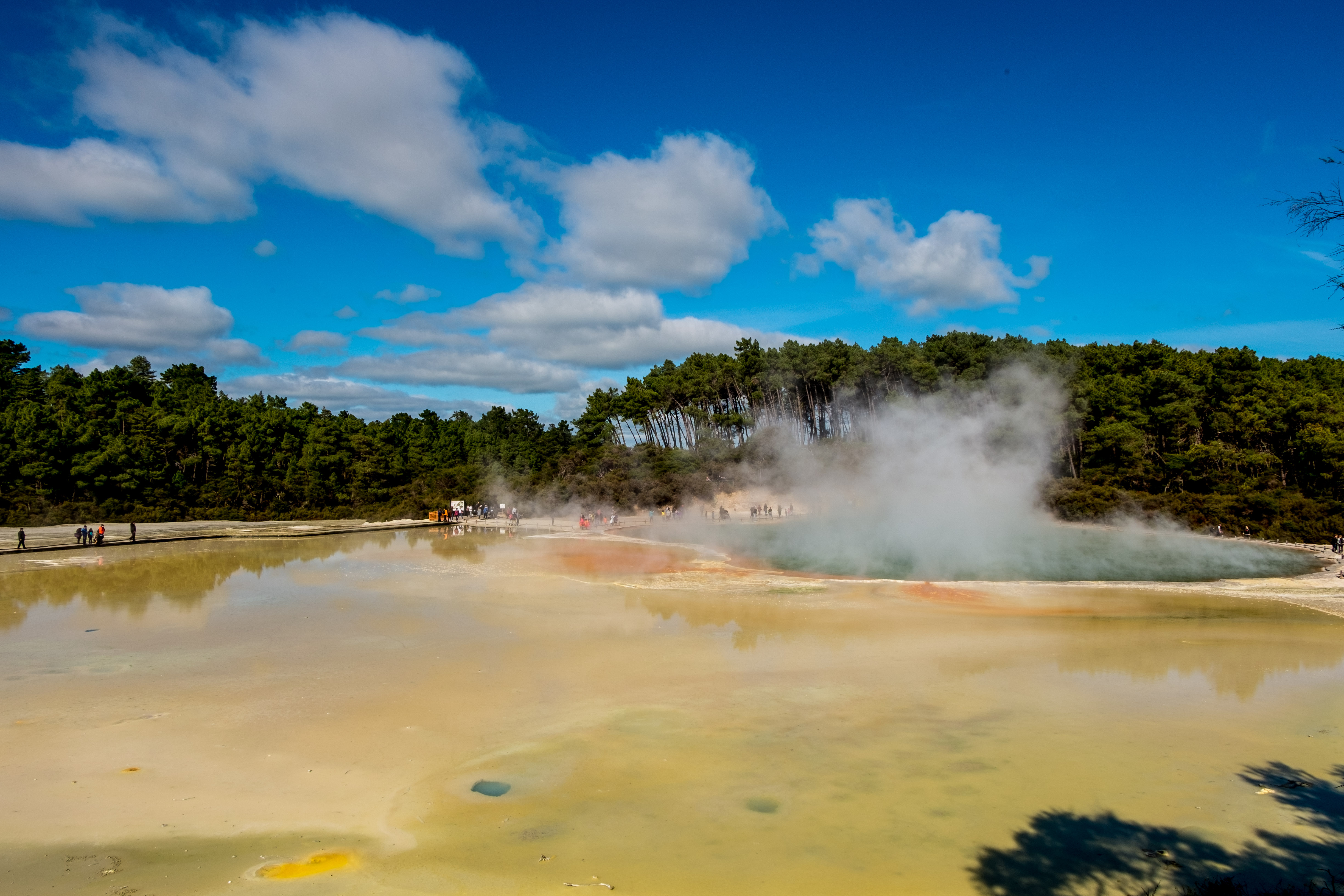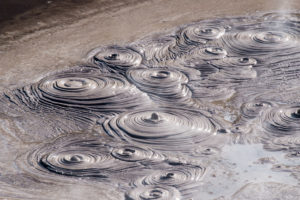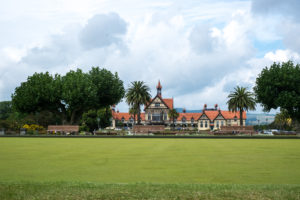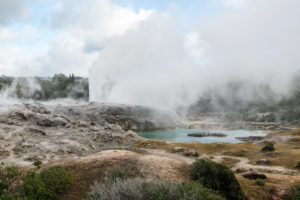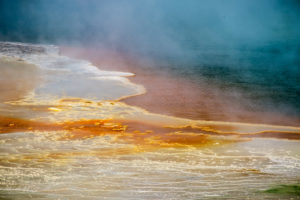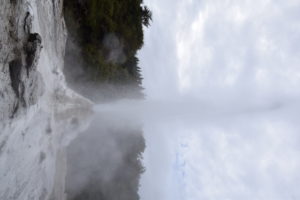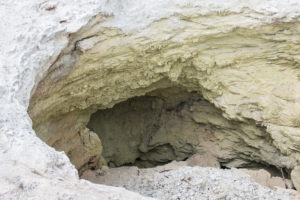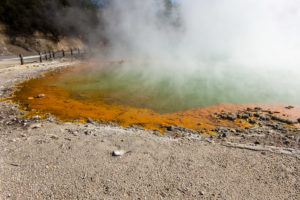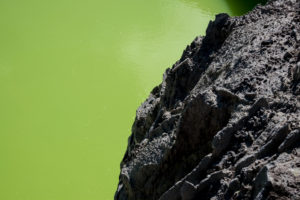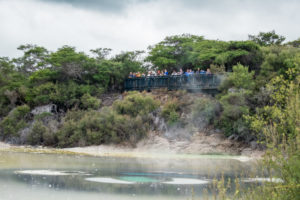Rotorua, the New Zealand geothermal activities capital
I am starting my 10th month in New Zealand and I realise that I almost did not speak about one of its most amazing characteristics : geothermal activities. In New Zealand this activity is the result of many volcanos in the country. It is possible to observe a lot of geothermal phenomena in the North Island : gas and smoke, craters, sulphur steam, natural hot pools…. All of this things appears mysterious and very intriguing to me. I remember very well the first time I saw some geothermal activities in last July. I had the sensation to finally really understand all the aspects of my sciences lessons. I realised how strong and clever is the nature, the Earth. All these terrestrial motions, underground movements, heat coming up to the surface to offer us a smelly and colorful show! I was curious and excited by those geothermal activities especially as they can be observed only in a few countries like in Yellowstone National Park in the United States, in Iceland and in New Zealand.
Sommaire
Rotorua, a city smelling rotten eggs
If you want to discover geothermal phenomena in Aotearoa the best thing to do is to go at Rotorua. Located along the same named lake and in an area of very important geothermal activity, Rotorua is one of the most visited cities in New Zealand. Many activities charge you a fee, but you will just need to stroll in the city to be able to see geothermal phenomena. Kuirau park is free and it is possible to see there a lake formed in a volcano crater, some mud pools bubbling because of the carbon dioxide and hot pools. It is even possible to bath your feet in one of these. But even before seeing all these things I was surprised by the smell surrounding all the city. It smells like rotten eggs! Actually it smells sulphur coming from all the small gaps and from the craters all around the city.
If you want to run away for this delicate smell and from the geothermal activities, there is a lovely walk along the lake and in the “Government Gardens”. Moreover, there are many gooses and black swans along the lake and a beautiful rose garden at the end of the park, just before reaching the Rotorua Museum. I did not visit the museum since it was close due to construction works. I can not tell if it is a good one or not but the outside is beautiful. This building which was a thermal establishment has a different architecture than what we’re used to see in New Zealand. As for me I like it. It gives colors to the city.
This walk is fully wheelchair accessible. There are some disable car parks along the lake in “Lakefront Drive” and the ground is flat.
I did not had the chance to bath in natural hot pool in Rotorua but I did it in Taupo and that is a must-do experience. It was awesome! Don’t hesitate to try this if you travel in New Zealand.
After this walk we have been to Whakarewarewa, a maori village of about 60 people, built in a very active geothermal area. All the village life is organised around geothermal activity from baths to meals. There are fees to pay ($NZ35) but if you want to know more about it you can read one of my posts about maorie culture.
Wai-o-tapu, a color explosion
Impossible not to stop at Wai-o-Tapu during a north island travel. At only 30 kilometres from Rotorua, Wai-o-Tapu is part of a naturel reserve. It is a bunch of all the most stunning and beautiful geothermal phenomena. I was amazed. We surely spent twice the normal time in the park as this is so hard to stop looking at all these colors and take pictures!
Before entering in the park we went to visit Lady Knox. In reality this Lady is a geyser which erupts everyday at 10am. Everyday at the same hour that sounds a bit suspicious, isn’t it? How can a geyser eruptions be so regular? Well, we just need to give it an hand! Actually some pastilles are put in the chimney to start the eruption. These are quite similar to soap except there are no chemical substance which can be harmful for the nature. Several seconds after putting this product in the chimney, the geyser eruption starts slowly. The spurt reachs between 10 and 20 metres high and can last for two hours maximum. It is quite impressive.
After that, it is time to discover the park itself. We are about to see many things : craters, mud pools, a lot of colors and this very specific sulphur smell. Right at the beginning of the visit we discover a big cavity in the ground made of pale yellow/greenish rocks. There are others craters and pools at different places in the park. These holes in the ground have formed when craters collapsed because of the soil acidity. A lot of steam escapes from this holes and stagnates above the lakes. It smells strong sulphur! Those steams even came to wrap us when we walk along the “Champagne Pool”. I felt almost as if I walk through a hammam.
The “Champagne Pool” is a 65 metres diameter and 62 depth metres volcano crater. The water surface is near to 75°C and comes to boil because of carbon dioxide. At the bottom of the crater the temperature reaches 260°C. The edges are orange and the centre is turquoise so it looks a bit unreal.
Under the ground many streams are heated by old magma left by the previous volcanic eruptions. The water is so hot that it absorbs all the minerals in the rocks when it passes through it. Then the water bring these minerals up to the surface and they are absorbed in the soil. that is why we can see all these marvellous colors. The edges orange colors is due to a high concentration of iron and antimony whereas the turquoise colors means that there is a lot of sulphur and ferrous salts.
I am astonished by these colors. It is crazy what can result from heat and minerals. After the “Champagne Pool” I continued my walk in the park and I thought I saw everything. A surprise was waiting for me : a green, very green lake. Like an apple. It will be even impossible to guess it is a lake if I picture only the green. This lake is called “Devil’s Bath”. That is a good name for it. I don’t really want to bath in it, rightly so, as it is green because of sulphurs and ferrous salt mixed with the “Champagne Pool” waters. It is a kind of acid pool.
It is possible to visit Wai-o-Tapu in a wheelchair. There are special parking spaces for disabled people near the main entrance and near the geyser entrance. There is a toilet suitable for wheelchair users near the main entrance. In the parc there are three different walks to do if you want to see everything. It is only possible to do the first one for wheelchair users. There are stairs in the two others. Anyway all the main things are along the first walk. Moreover, the park is free for disabled people. So there is no reason not to go for it! All along the visit there are some view platforms but they are surrounded by wooden barriers to protect people to fall in the hot waters. Unfortunately these barriers are quite high and wheelchair users must look between the bars. In some places barriers are lower which allows a better view. For example the “Champagne Pool” is perfectly visible.
For manuel wheelchair travellers it will be necessary to have a person to help as there are steep slopes at the beginning and at the end of the pathway. There is not concrete on the ground. It is uneven, a bit powdery, with some irregularities but it is compact. Some parts of the pathway are boardwalks.
You want to travel all around New Zealand? Find many ideas of awesome destinations in north island and south island in my other articles as well as wheelchair accessibility tips.
Did you like this post? Feel free to check out my Patreon page to see how you can support the creation of new ones and be a part of iwheeltravel!
And of course, you can share, like and subscribe, to be aware of the lastest posts.

